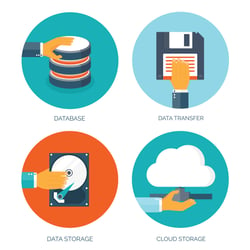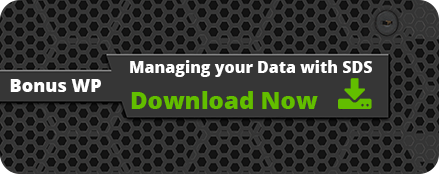 There are a couple of reasons why organizations are slow to adopt software defined storage (SDS) when compared to its cousin, software defined networking (SDN). This is likely due to the concept of utilizing commoditized hardware. After all, if a switch goes down, it’s just a switch. If a RAID (Redundant Array of Independent Disks) goes beyond the point of degradation, it’s your own valuable data, which is why enterprises have been willing to pay such absorbent costs on proprietary disk array devices that boast enormous levels of redundancy. In addition, some of the terminology frequently used to describe various aspects of SDS can be confusing.
There are a couple of reasons why organizations are slow to adopt software defined storage (SDS) when compared to its cousin, software defined networking (SDN). This is likely due to the concept of utilizing commoditized hardware. After all, if a switch goes down, it’s just a switch. If a RAID (Redundant Array of Independent Disks) goes beyond the point of degradation, it’s your own valuable data, which is why enterprises have been willing to pay such absorbent costs on proprietary disk array devices that boast enormous levels of redundancy. In addition, some of the terminology frequently used to describe various aspects of SDS can be confusing.
For example, many people may assume that a virtual storage appliance (VSA), one of the more popular component choices of SDS, is a hardware appliance rather than simply a software bundle. In this blog post, we lay out the motivations and benefits of converting hardware-based storage infrastructure to a system that’s software defined. We also offer advice for ensuring your data is safe, secure and most importantly, accessible.
Keeping Up with an Exponential Amount of Data
We are all aware of the mind-numbing growth of data being generated today. Those who work in the Information Technology field are quite familiar with Moore’s Law which says that processing power doubles every two years. Amazingly, that statistic still holds true today – nearly a half century later. Similarly, the “Knowledge Doubling Curve,” created by the visionary inventor and author Buckminster Fuller, cited the exponential doubling of knowledge which regularly occurs, and is rapidly increasing. Up until 1900, human knowledge was doubling approximately each century. By the end of World War II, this window had been narrowed to 25 years. It is currently estimated that human knowledge is doubling every 13 months. According to IBM, the coming age of the Internet of Things will amazingly result in a doubling of knowledge every 12 hours!
According to IDC, more than 30,000 PB of new external storage system capacity was purchased in 2014 alone, an increase of 30 percent over the prior year. Beyond simply being aware of this growth, we must also learn to master the ability of maximizing the value of this vast amount of data. In order to contend in the highly competitive global economy in which we operate, IT managers must create a data structure that gives users the ability to access information, process it and bring it to value as quickly as possible.
Determine the Business Value of Disconnected Data
We often correlate enterprise data with structured data; a healthcare organization is a great example. Structured data such as the name, address, age and gender of patients are routinely collected and stored in some type of database silo. However, this structured data only comprises ten to twenty percent of all collected data. Most patient data is derived in the form of physician notes, patient histories, hospital admission and discharge summaries. These are examples of what is referred to as unstructured data. There is a plethora of value within this data for improving outcomes and reducing costs. The problem is that this data is stored in formats that make it inhibitive to retrieve using most common storage infrastructures. The data may also reside in silos segregated from most users, making it inaccessible.
Paul Muller, Chief Evangelist and VP of Strategic Marketing for HP Software calls unstructured data “disconnected data.” He emphasizes that this type of information is dead data. He uses the example of a company’s voicemail that records incoming calls made by its customers. “A lot of rich data is contained in these recordings, such as the actual messages, as well as the voice inflection used in them,” he says. The problem is that it is isolated. Many times, IT management finds themselves guessing when it comes to decision making, yet there is so much data stored within the organization that could offer them the ability to absolutely know – rather than just guess.
There is great value in not having to speculate. This is the potential that underutilized or even ignored data sources hold in providing real actionable insight into management decisions. There is so much untapped knowledge within all forms of unstructured data such as social media activity, spreadsheets, live chat conversations with customers, logs, documents and other types of inter-company processes that can vastly increase the clarity for company decision making.
Innovation is originated from data, reinforced by data and efficiently delivered by data. In the previous ten years, enterprises adopted computer virtualization in order to achieve the states of agility and flexibility that business demands today. In the coming ten years, the challenge will be to transform the data infrastructure into highly efficient and elastic pools that innovation demands. Is your organization ready to reach the full potential of its data and leverage software defined storage?
For a more in-depth look at SDS and how it can help you organize your data for actionable insights, read the white paper Managing your Data With Software Defined Storage.












